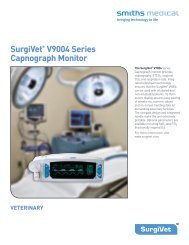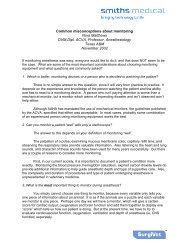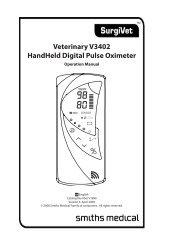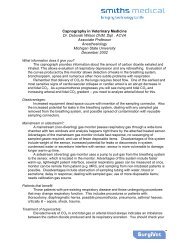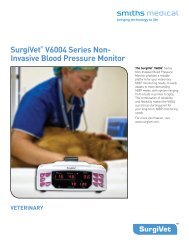Direct Arterial Blood Pressure Monitoring - SurgiVet
Direct Arterial Blood Pressure Monitoring - SurgiVet
Direct Arterial Blood Pressure Monitoring - SurgiVet
Create successful ePaper yourself
Turn your PDF publications into a flip-book with our unique Google optimized e-Paper software.
<strong>Direct</strong> <strong>Arterial</strong> <strong>Blood</strong> <strong>Pressure</strong> <strong>Monitoring</strong><br />
Angel M. Rivera CVT, VTS (ECC)<br />
Animal Emergency Center<br />
Glendale, WI<br />
March 2003<br />
Introduction<br />
<strong>Direct</strong> measurement of arterial blood pressure is obtained via a peripheral artery catheter<br />
that is connected to a transducer and is a continuous display/recording device or monitor. Intraarterial<br />
or direct blood pressure provides a continuous display of the arterial waveform along<br />
with measurements of mean arterial pressure, systolic and diastolic pressure.<br />
<strong>Monitoring</strong> direct arterial pulse pressure provides valuable information in terms of pressure<br />
value or measurement, but it also provides valuable information in terms of its shape and<br />
contour. The arterial pulse wave can exhibit changes that are related to specific underlying<br />
pathology.<br />
Indications for the use of direct arterial blood pressure monitoring include shock, critical<br />
illness, peripheral vasoconstriction, and intra-operative and post-operative monitoring of highrisk<br />
patients. In addition, arterial catheters allow for frequent monitoring of blood gas<br />
measurements.<br />
Basic Physiology<br />
<strong>Arterial</strong> blood pressure is generated by the ejection of blood from the left ventricle (LV) into<br />
the arterial vasculature. The amount of pressure generated is determined by the volume of<br />
blood ejected as well as the resistance to ejection within the systemic vascular network. In other<br />
words:<br />
PRESSURE= Flow X Resistance<br />
As blood is ejected into the proximal portion of the aorta, the vessel wall stretches and<br />
distends to accommodate the increase in volume. This stretching of the aortic segment is<br />
transmitted peripherally along adjacent segments of the aorta, thus producing a pulse wave that<br />
is transmitted through the arterial circulation and felt peripherally as a pulse.<br />
The rate at which the pulse travels down the aorta is determined by the compliance and<br />
distensibility (vasodilation) of the arterial system. Decreases in compliance (hypertension or<br />
vasoconstriction) results in a rapid transmission of pulse wave. As the pulse travels peripherally<br />
from the central aorta, it changes shape as well as value. This occurs as a result of the<br />
reflected waves that summate on the primary systolic wave.<br />
The arterial pressure wave is divided into two phases that correspond to the cardiac cycle:<br />
systole and diastole. <strong>Arterial</strong> systole begins with the opening of the aortic valve and the rapid<br />
ejection of blood into the aorta. This is followed by “run-off” of blood from the proximal aorta to<br />
the peripheral arteries. On the arterial pressure waveform, this appears as a sharp rise in<br />
pressure followed by a decline in pressure. As pressure falls, the aortic valve snaps shut,<br />
causing a small change in arterial pressure that appears as a dip on the down slope. This is
termed the “incisure” in central aortic pressures and the “dicrotic notch” in peripheral pressures.<br />
This marks the end of the ejection period.<br />
The “peak systolic pressure” is a reflection of maximum pressure generated by the LV and is<br />
normally 100-140 mmHg. Systolic pressure is frequently used to monitor ventricular “afterload”.<br />
Afterload is defined as LV wall tension during systole. The two principal determinants are<br />
systolic pressure and the radius of the left ventricle (related to LV volume) is assumed to remain<br />
relatively constant, and therefore systolic pressure is the parameter used to clinically monitor<br />
after loads.<br />
Diastole follows closure of the aortic valve and continues until next systole. During this time,<br />
”run-off” to the peripheral arteries occurs without further flow from the LV. On the peripheral<br />
arterial waveform this is seen as a gradual decrease in pressure. The lowest point on diastole<br />
(end-diastole) is referred to as arterial diastolic pressure and is normally 60-80mm Hg.<br />
The diastolic arterial blood pressure reflects both the velocity of “run-off” and the elasticity of<br />
the arterial system. The elastic properties of the vessels affects the arterial system’s ability to<br />
change luminal dimensions as blood volumes change. Heart rate also affects the diastolic<br />
pressure because it determines the duration of diastole in the cardiac cycle. The longer the<br />
period of time and the shorter the diastolic period (with tachycardia), the higher the diastolic<br />
pressure.<br />
Diastolic pressure is also important in determining coronary perfusion, especially to the left<br />
ventricle, where most flow occurs during diastole. Normal coronary artery perfusion pressure is<br />
60 to 80 mm Hg. Perfusion pressures below 50 mmHg threaten myocardial<br />
perfusion.<br />
The arterial pressure differs in both contour and value depending on location of the artery.<br />
The systolic pressure tends to be higher in the femoral artery than in the radial or brachial artery<br />
by as much as 25 to 50 mmHg. Generally, the diastolic and mean arterial pressure (MAP)<br />
remains nearly the same.<br />
Normal arterial blood pressure is approximately 120/80 mmHg in the healthy dog and cat.<br />
Systolic pressure greater than 180mmHg and diastolic pressures greater than 120mmHg are<br />
suggestive of hypertension. MAP is defined as the sum of diastolic pressure plus one third of<br />
the pulse pressure. It can also be mathematically calculated as:<br />
MAP = Systolic pressure + (Diastolic pressure X 2)<br />
3<br />
MAP represents the average pressure within the arterial system. Since diastole typically<br />
lasts approximately two thirds of the entire cardiac cycle, the mean arterial pressure value is<br />
closer to diastolic value than to the systolic value. Even though, the arterial pressure pulse is<br />
amplified as it travel away from the heart, the MAP remains relatively unchanged, thus its<br />
importance as a reflection of overall perfusion. Normal MAP is 70-90 mm Hg. MAP dependent<br />
on two factors:<br />
1. Cardiac Output (CO): The blood flow through the vessel.<br />
2. Systemic Vascular Resistance (SVR): The elasticity of resistance of the vessels.
The above interrelationship can be expressed as:<br />
MAP= Cardiac output X Systemic vascular resistance.<br />
The pulse is the difference between the systolic and diastolic pressure. In other words:<br />
Pulse <strong>Pressure</strong> = Systolic <strong>Pressure</strong> - Diastolic pressure<br />
The pulse pressure is largely determined by stroke volume (amount of blood ejected with<br />
each contraction), the compliance or distensibility of the arterial network and the character of<br />
ejection from the heart during systole. Thus, it is said that pulse pressure is reflective of stroke<br />
volume and arterial compliance. Any factor that increases stroke volume, such as decrease in<br />
pulse rate or an increase in CO, also increases pulse pressure. A decrease in compliance or<br />
distensibility of the arterial network also tends to increase pulse pressure. In the emergency<br />
and critically ill patient, wide pulse pressures are associated with large stroke volumes, and<br />
narrow pulse pressures are seen with low stroke volume.<br />
The pulse pressure and not the systolic blood pressure largely determine the strength of a<br />
pulse on palpation. A weak peripheral pulse is generally associated with a stroke volume that is<br />
lower than normal. This could be due to a rapid pulse rate or decreased cardiac output.<br />
However, it is important to remember that, weak peripheral pulses at the extremities can also be<br />
due to arteries and arterioles severely constricted.<br />
Pulse pressures changes reflect alterations in cardiac output much more accurately than<br />
systolic blood pressure as shock develops. In hypovolemic shock, major decreases in stroke<br />
volume and pulse pressure as often occur long before there is significant fall in the systolic<br />
pressure. Diastolic pressure often rises initially with hemorrhage due to sympathadrenal<br />
stimulation, particularly if there is pain or tissue damage. Since vasoconstriction can increase<br />
only to a certain maximum, continued blood loss will eventually result in a fall in both systolic<br />
and diastolic pressures.<br />
Therefore, in an individual patient, changes in pulse pressure can often correlate quite well<br />
with changes in stroke volume. An example of this can be of a patient’s blood pressure<br />
changing from 120/80 to 110/90. In this particular case, the pulse pressure has fallen from 40<br />
mm Hg to 20 mm Hg. A 50% decrease in pulse pressure, could also signify a 50% decrease in<br />
stroke volume.<br />
Intra-arterial or direct arterial pressure measurement<br />
The three components or characteristics of intravascular pressures measured through a<br />
fluid- filled catheter are:<br />
• Residual or static pressure inside the fluid-filled vessel<br />
• Dynamic pressure, which is caused by the imparted kinetic energy of the moving fluid<br />
(similar to the encountered in arterial pressures when the catheter tip is directly facing the<br />
flow of fluid).<br />
• Hydrostatic pressure, which results from the difference between the ends of the fluid-filled<br />
tubes) the tip of the catheter and the air-reference port of the transducer).
The most desired measurement during hemodynamic monitoring is residual or static,<br />
pressure within the vessel or chamber being assessed. To achieve this goal, both dynamic and<br />
hydrostatic pressure components need to be eliminated. As stated above, dynamic pressures<br />
are encountered only in high or frequent flow rates or when the catheter tip is directed into the<br />
flow. This component is greatly reduced when assessing arterial blood pressure by the use of<br />
dampening services.<br />
The hydrostatic pressure is the component to most consistently interfere with the accuracy of<br />
pressure measurements obtained through fluid-filled systems. Placement of the air-reference<br />
port at the level of the right atrium eliminates the effects of hydrostatic pressure within the fluidfilled<br />
column and provides accurate measurement within the peripheral artery.<br />
All biomedical devices consist of three basic components:<br />
1. Transducer or device that detects the physiological event.<br />
2. An amplifier that increases the magnitude of the signal from the transducer.<br />
3. A recorder, meter, oscilloscope or monitor to display the signal.<br />
TRANSDUCERS<br />
The measurement of pressures requires the transformation of a biophysical event into an<br />
electrical event or signal, which can then be displayed, recorded and quantified. This<br />
transformation is done with the transducer.<br />
Depending on its application, transducers can sense changes in flow, color, temperature,<br />
concentration, pressure, displacement, light intensity, frequency, sound and other physiological<br />
changes. They are classified according to the type of energy to which they are sensitive and<br />
the method of energy coupling used. The pressure transducer most commonly used in<br />
biomedical instrumentation is the mechanical or displacement. Mechanical or displacement<br />
transducers consist of a mechanical element that is displaced as a result of changes in<br />
pressure. The most commonly used type of displacement transducer is the strain gauge<br />
transducer.<br />
Strain gauge transducers are sensitive to temperature changes (typically 0.1 mm Hg/1° C)<br />
and require occasional checking of the zero-pressure baseline for drift. The room in which they<br />
are being used should be maintained at a fairly constant temperature. Solutions flushed through<br />
the transducers can also cause temperature variance and baseline drifts to occur.<br />
AMPLIFIERS<br />
Amplifiers are used to boost the size of a signal by a factor of 1,000 before it can be<br />
displayed. They can be straightforward electronic devices that simply amplify the signal from<br />
the transducer, or they can be highly complex devices that process, filter and amplify the signal<br />
to display on the oscilloscope and record. The signal can be fed into a computer for further<br />
digital processing and analysis.<br />
Amplifiers should filter out other physiological signals and undesired environmental noise<br />
detected by the transducer. The amplifier’s ability to increase the signal level and its accuracy<br />
in reproducing signals from input to output should not add significant distortion (termed linear<br />
response). Calibration, stability, and temperature drifts should minimally affect the signal.
ZERO DIFFERENCE<br />
The weight of air or atmospheric pressure must be eliminated from pressure measurements<br />
dependent on altitude and environmental factors. Atmospheric pressure is about 760 mm Hg at<br />
standard temperature and pressure at sea level. This is achieved by opening the transducer to<br />
air, and adjusting the display system to read zero. By doing so, all pressure contributions from<br />
the atmosphere are negated, and only pressure values that exist in the vessel will be measured.<br />
CALIBRATION<br />
Accurate quantitation of recorded pressure measurements requires precise calibration of<br />
both transducer and the amplifying electrical components. Most monitors have a built-in<br />
electrical calibration that yields a known pressure value. This calibration should be checked<br />
before hemodynamic monitoring is initiated. To avoid electronic drifts, the instrument should be<br />
allowed to warm up for approximately 15 minutes.<br />
Calibration steps are:<br />
1. Depress the “CAL” button on the monitor.<br />
2. After the readout stabilizes, use the control knob to adjust and obtain the appropriate<br />
readout value (e.g.160, 200mm Hg).<br />
3. Release the “CAL’ button and make sure the reading returns to zero.<br />
NOTE: This procedure assesses the electrical calibration of the system. It DOES NOT check<br />
the calibration of the transducer.<br />
TRANSDUCER CALIBRATION<br />
All disposable transducers are pre-calibrated and coded by the manufacturer and are<br />
considered to be accurate at the time of use. However, as with any sensitive instrument they<br />
can be easily damaged. The calibration of the transducer can be checked in the following<br />
manner:<br />
1. Attach a 3 or 4 foot long extension tubing to the side port of an in-line stopcock.<br />
2. Turn the stopcock open between the infusion bag and the attached extension tubing<br />
and completely fill the tubing with fluid.<br />
3. Vertically hold or mount the fluid filled extension tubing above the transducer.<br />
4. Turn the stopcock open between the fluid filled extension tubing and the transducer.<br />
5. Check the digital readout on the monitor.<br />
a. A 3-foot fluid filled tubing should exert a pressure of 67mm Hg (+/-1).<br />
b. A 4-foot fluid filled tubing should exert a pressure of 90mm Hg (+/-1).<br />
Equipment<br />
1. Catheter of choice.<br />
2. <strong>Pressure</strong> transducer.<br />
3. Electronic monitor or oscilloscope.<br />
4. Plastic IV heparinized fluid bag.<br />
5. Pediatric IV.<br />
6. Three way stopcocks.<br />
7. Continuous flush device.
8. Pressurized IV cuff or pump.<br />
Equipment Set Up<br />
1. Plug transducer cable into the monitor.<br />
2. Select appropriate scale on monitor.<br />
3. Turn monitor power switch on.<br />
4. Add heparin 1 unit per each ml of fluid. And label bag.<br />
• Using a sterile needle, remove all air from the IV heparin flush bag via the<br />
medication port.<br />
5. Connect IV pediatric set to heparin flush bag.<br />
• Lightly squeeze the drip chamber.<br />
• DO NOT fill chamber more than 0.5 cm, since the fluid level will increase when pressure<br />
is applied to the bag.<br />
• DO NOT prime the IV tubing at this point.<br />
6. Close the IV line roller clamp, insert the IV bag into the pressure administration<br />
cuff, and hang the pressure cuff.<br />
• DO NOT pressurize bag at this point.<br />
7. Replace all caps on the stopcock with injection caps on the sideports of all<br />
stopcocks.<br />
8. Attach the IV set to the designated end of the continuous flush device.<br />
9. Attach a venting stopcock to one port of the transducer. (NOTE: Some transducer may<br />
come preassembled).<br />
10. Attach a luer LUER LOCK stopcock the remaining transducer dome (if applicable).<br />
11. Attach the female end of the continuous flush device to the LUER LOCK stopcock on the<br />
transducer dome.<br />
12. Open the transducer- venting stopcock to air.<br />
13. Open the IV roller clamp.<br />
• Pull the fast flush device and allow the IV solution to fill the tubing, the<br />
stopcocks, the flushing device and the transducer dome.<br />
• NOTE: It may be necessary to rotate the transducer dome while fasting-flushing to<br />
purge all air bubbles from dome.<br />
14. Close the transducer-venting stopcock.<br />
15. Remove dead-ender cap at patient end of the connecting tubing.<br />
• Attach a LUER-Lock stopcock (if not pre-assembled) and close off all its side ports.<br />
16. Pull fast flush device and slowly flush entire monitoring line (using only gravity).<br />
• Take special care that no air is trapped in any stopcocks.<br />
17. Pressurize cuff on IV flush bag to 300 mm Hg.<br />
• Make sure drip chamber DOES NOT completely fill.<br />
• Set drip rate between 1 to 5 mls/hr.<br />
18. Allow catheter hub to fill with blood.<br />
• While holding the fast flush device open, connect IV line to the catheter,<br />
• Reassess drip rate to to ensure a rate of 1 to 5 mls/hr.<br />
19. Check all connecting sites.<br />
20. Place transducer air- reference stopcock at level to patients thoratic inlet and secure.<br />
• This positioning should be approximate to the level of the right atrium.<br />
21. Open the air reference stopcock to air.<br />
22. Turn the ZERO control knob on the monitor to obtain a zero reading.
23. Push the calibration knob and recheck the monitor calibration.<br />
• Adjust if necessary<br />
24. Close the transducer-venting stopcock to air.


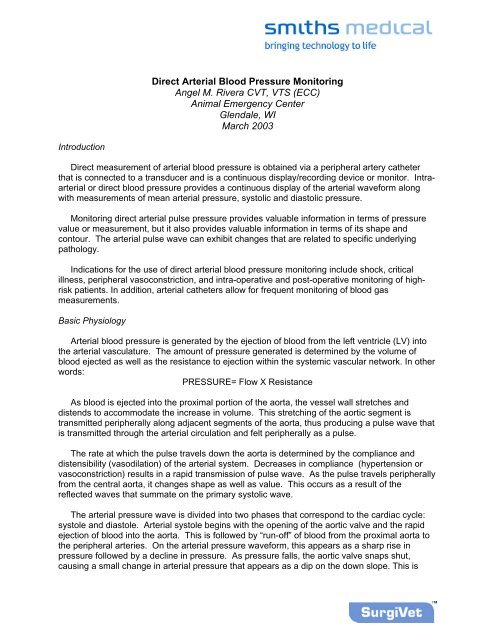
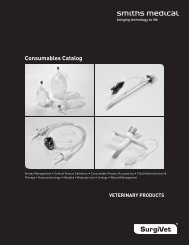
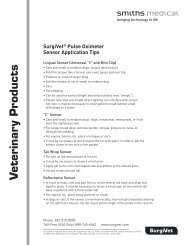
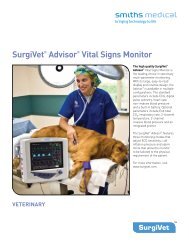
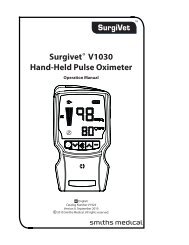
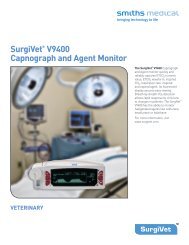
![Redemption Form [PDF] - SurgiVet](https://img.yumpu.com/37386077/1/190x245/redemption-form-pdf-surgivet.jpg?quality=85)
![Redemption Form [PDF] - SurgiVet](https://img.yumpu.com/37386066/1/190x245/redemption-form-pdf-surgivet.jpg?quality=85)
